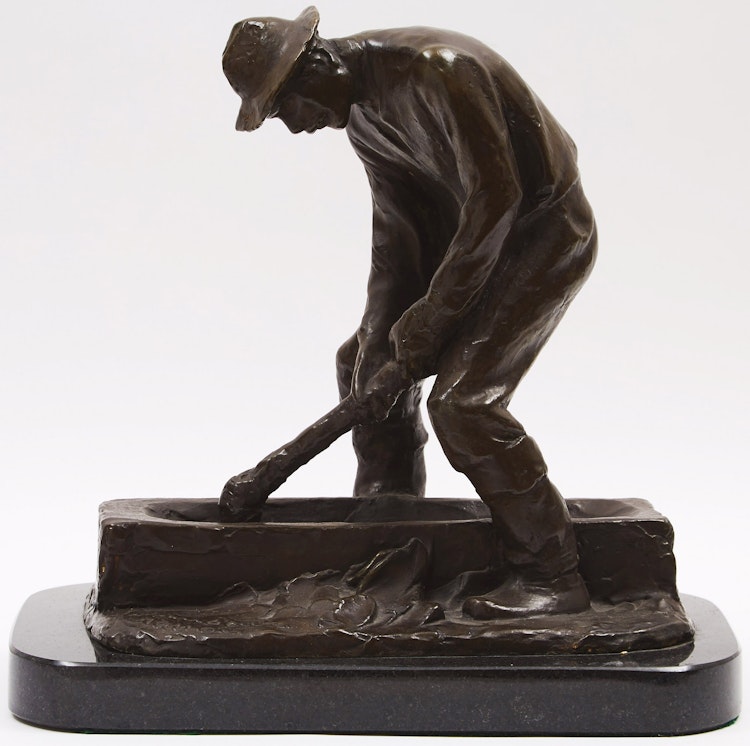Le creuseur d’auge by Alfred Laliberté

Alfred Laliberté
Le creuseur d’auge
bronze
incised with the artist’s signature, title and “Roman Bronze Works, New York”; mounted on a marble base
12 x 11.5 x 6.25 ins ( 30.5 x 29.2 x 15.9 cms ) ( overall, excluding base )
Auction Estimate: $2,500.00 - $3,500.00
Price Realized $3,120.00
Sale date: May 31st 2022
Private Collection, Ontario
Share this item with your friends
Alfred Laliberté
(1878 - 1953)
Born at Ste. Élizabeth, Arthabaska, Laliberte attended the Conseil des Arts et Métiers, in Montreal. When he was twenty-four, a public subscription helped finance his study in Europe and one of his greatest supporters was Sir Wilfred Laurier. Through this support, Alfred Laliberte studied at the Ecole des Beaux Arts in Paris in 1902 under Gabriel Jules Thomas and Antoine Injalbert. In 1904, he exhibited his sculpture at the Salon de Paris and received ‘special mention’ for his “Jeunes Indiens Chassant” (Young Indians Hunting) now in the National Gallery of Canada. He also exhibited in Paris in 1905 and 1906. He returned home but made visits to France in 1910, 1917 and 1923. He was elected an Associate of the Royal Canadian Academy in 1912 and became a full member in 1919.
One of his most remarkable undertakings was a series of bronze figures depicting the history of French Canadians. The series was divided into three categories: crafts, customs and legends. They were modelled in clay and then cast in bronze. This series, which included 215 subjects, was purchased by the Province of Quebec and placed in the Quebec Provincial Museum. The whole project from its earliest conception, through planning and realization took Laliberte nearly fifteen years. But the series was only a part of his life’s work of 700 works. He did about 200 paintings, 100 or so silver rings and other items such as pendants, bracelets, shoe and belt buckles. He wrote his memoir in four parts. Laliberte established a workshop at 3531 rue Sainte Famille which he built in 1920. Maurice Cullen, Robert Pilot, Sherriff Scott, Jean Palardy and Mario Merola all worked there. It was Laliberte’s great wish that his house and workshop should become a museum after his death. He purchased about 100 paintings of other Canadian artists and was regarded as being generous and noble. He encouraged many artists and was a professor at the Ecole des Beaux Arts in Montreal. His bronze figures were exhibited in the French pavilion at ‘Man and His World’ in 1968.
At the time of Alfred Laliberte’s death the following comments appeared in the Montreal Star, “Laliberte worked for the most part on the monumental scale and will be remembered best for his work in this field, but scattered about the world, recognized as fine work, are many of his portrait busts, medallions and medals. He will be remembered here, too, for having created on Ste. Famille Street something that became an art centre in the city. It was he who built the studio building there which housed artists of such renown as Cullen and Pilot and still served another generation of painters and sculptors. Quebec is rich in artists who pursue the historical tradition. Alfred Laliberte was not the least of these.”
Laliberte was survived by his wife who until her death lived at the Ste. Famille studio building which has tragically fallen victim to the wrecker’s hammer. Laliberte received an Honorary Doctorate from the University of Montreal (1940); Member l’Académie des Beaux-Arts de I’Institut de France, Sculpture Section (1948).
Source: "A Dictionary of Canadian Artists, Volume II”, compiled by Colin S. MacDonald, Canadian Paperbacks Publishing Ltd, Ottawa, 1979

